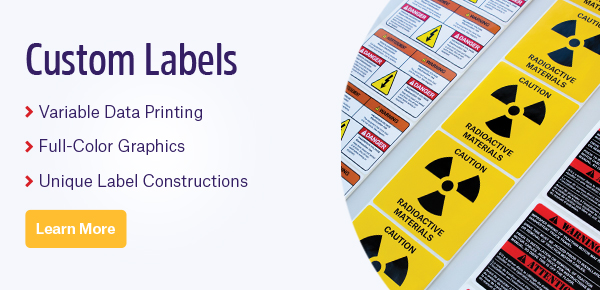
Labels are essential to tire manufacturers and companies that sell and store their tires. Two types of labels are predominantly used: tire bead labels to track throughout manufacturing and tire tread labels for retail and storage purposes.
Tire Bead Labels
Tire parts differ, from the tread to the shoulder, down to the inner flap area called the bead. Barcoded labels are placed on the bead to help track each tire during work in progress (WIP) of manufacturing.
Manufacturing of tires consists of six main steps: mixing, calendaring, building, curing (also called vulcanizing), finishing, and distribution. Identification solutions can be used as early as the calendaring phase to track the sheets of rubber. Although you are not required to track the tire from this stage, the earlier in the manufacturing process the tire label is applied, the easier it will be to figure out if there was an issue at later stages. After calendaring, tires move to the building phase where the tire takes its shape, forming what is called a “green tire”. A green tire is a tire that has not been cured (or vulcanized) and is still missing its groove patterns on the tread. This is commonly when a barcode label should be placed on the bead to track the tire through the rest of the manufacturing process.
Vulcanized Tire Labels
Tire bead labels are also referred to as vulcanized labels if they are placed on a green tire and therefore require resistance to the vulcanization process. The vulcanization (or curing) process in tire manufacturing is a challenge for these labels. Heat (up to 200°C) and high pressure can easily damage a label. It is important to note that whether you add a tire label during calendaring or before curing, both will be subject to heat and pressure. Due to vulcanization and the rigors of tire manufacturing, it is important to choose durable label materials that withstand extreme heat, preventing smudging of barcodes and oozing of adhesives. Thermal-transfer printed labels give you the best durability option.
Labels are typically designed to adhere to the surface of a material, whereas tire bead (or vulcanized) labels can be melded right into the tire. Doing this provides an extra level of protection and allows manufacturers to scan the barcoded label to determine if their tire is safe and ready for sale. If the tire is deemed ready for sale, a more visually appealing label will be adhered to its outer tread and shipped to retail providers.
Tire Tread Labels
Tire tread labels are created with attractive graphics and valuable information for companies and consumers. The printing area contains country-specific regulations, a barcode(s), and marketing to motivate purchase. We recommend flexographic printing for vibrant colors that will make your branding standout, combined with convenient, on-demand thermal-transfer printing for variable information and barcodes.
The adhesive of the tire label must be suitable for the slick outer coating on the tread. Tire labels must securely adhere to the surface without damaging coating when removed. Label companies must get this right and will be required to customize tire tread labels to meet specific requirements, including accurately presenting government requirements.

Tire Label Requirements in the US and EU
In the US, tire tread labels are required to display the UTQG (Uniform Tire Quality Grading), which tests temperature and heat resistance, graded from A through C, and traction, graded AA, A, B, or C. These labels also display the tread wear, which can be up to 100, the maximum load, speed range, the Department of Transportation identification number, temperature rating, load index, and alphanumeric code data.
In the EU, tire labels (spelled tyre labels in the UK) provide clear information of how the tire will handle specific environments, safety characteristics of the tire based on fuel efficiency, wet braking, and noise level. Fuel efficiency is rated from A through G, showing consumers which tires will consume less fuel. Wet grip is vital for driving safely during wet conditions, with the tire’s performance once again graded from A through G. Noise level represents how much noise the rolling of the tires make; it is measured in decibels. Lower noise levels range between 67 and 71 dB, while higher levels are at around 72 and 76 dB.
Tire Storage
Extreme weather and chemical exposure present the most common challenges for tire lidentification during storage. A tire tread label tested to withstand these conditions and adhere throughout them will help mitigate the risk of damage. We recommend against stapling labels as you increase the risk of damaging the tires. Handwritten labels are also unreliable. Instead, car dealers, mechanic shops that store tires, storage facilities should look for a durable thermal-transfer printable tire tread label that will endure harsh storage environments.
Label companies provide value to the automotive industry and tire manufacturers by creating durable, attractive identification solutions, adhesives that remain intact, and printed data that does not smudge during manufacturing, transport, and storage.
IndustriTAG Tire Labels
IndustriTAG proudly supports tire manufacturers and retailers worldwide with quality labeling solutions. Visit our website to learn more at indistritag.com and order your free label samples today! Imagine the difference IndustriTAG labels will make for you and your customers.
INDUSTRY HISTORY:
Vulcanize is a term coined by Charles Goodyear, yes, that Goodyear. He is responsible for vulcanized rubber and patented his invention in 1844. The word is derived from Vulcan, the Roman god of fire and forge.

